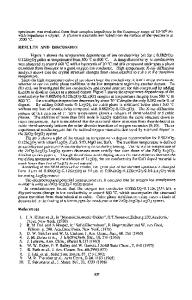Influence of frequency and gamma irradiation on the electrical characteristics of Er 2 O 3 , Gd 2 O 3 , Yb 2 O 3 , and H
- PDF / 2,131,483 Bytes
- 42 Pages / 595.276 x 790.866 pts Page_size
- 65 Downloads / 337 Views
Influence of frequency and gamma irradiation on the electrical characteristics of Er2O3, Gd2O3, Yb2O3, and HfO2 MOS-based devices Aysegul Kahraman1
, Seetharama C. Deevi2,3,5,*
, and Ercan Yilmaz4,5
1
Department of Physics, Bursa Uludag University, 16059 Bursa, Turkey Department of Physics, Virginia Commonwealth University, Richmond, VA, USA 3 Energy, Materials and Manufacturing, Midlothian, VA 23113, USA 4 Department of Physics, Bolu Abant Izzet Baysal University, 14030 Bolu, Turkey 5 Nuclear Radiation Detectors Applications and Research Center, Bolu Abant Izzet Baysal University, 14030 Bolu, Turkey 2
Received: 28 January 2020
ABSTRACT
Accepted: 3 March 2020
The unique physical, chemical, and electronic properties of rare earth oxides have been of immense interest to replace SiO2 as a dielectric material in metal– oxide–semiconductor (MOS)-based sensors applications to accurately measure the radiation dosage and increase sensor sensitivities in as diverse applications as space radiation, nuclear physics, medical diagnostics, radiation cancer therapy, and personal dosimetry devices. Hence, the electrical characteristics of oxides prior to and after irradiation of MOS-based devices are needed since they are the backbone of the devices such as MOSFETs and ICs. In addition, an understanding of the behaviour of high-k dielectric oxides in an MOS configuration is necessary since the radiation-induced damage occurs in the bulk oxide film and/or near the oxide–semiconductor interface resulting in creation of lattice defects. Hence, MOS structures with the rare earth oxides of Er2O3, Gd2O3, Yb2O3, and a transition metal oxide of HfO2 were produced by RF magnetron sputtering to determine (a) the structure of the films, (b) dielectric constants, (c) capacitance versus voltage behaviour of Er2O3, Gd2O3, Yb2O3, and HfO2 prior to and after irradiation of the devices in the dose range of 0–76 Gy. The experimental results were analysed with a theoretical framework on the energy band diagram and the radiation effects on the electrical characteristics of the MOS capacitors. The characteristics of the devices were evaluated by using effective oxide charge density (QEFF ), variation in the oxide trapped charge density (DNox ), and interface trapped charge density (DNit ). In addition, barrier height (/b ), image force barrier lowering (D/b ), acceptor concentration (Na ) were calculated before and after irradiation and examined the nature of interface states. The radiation responses of the Er2O3 and HfO2 MOS capacitors did not
Ó
Springer Science+Business
Media, LLC, part of Springer Nature 2020
Address correspondence to E-mail: [email protected]
https://doi.org/10.1007/s10853-020-04531-8
J Mater Sci
show a stable behaviour with an increase in radiation dose due to possible neutral electron trap centres. Contrary to expectations, we infer that more negative charges are trapped in Gd2O3-based device than positive charges with an increase in radiation dose. The C–V curves of the Yb2O3 MOS capacitor shifted in the same d
Data Loading...











